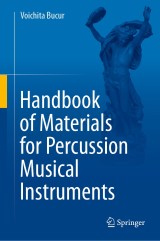Details

Handbook of Materials for Percussion Musical Instruments
|
287,83 € |
|
| Verlag: | Springer |
| Format: | |
| Veröffentl.: | 07.07.2022 |
| ISBN/EAN: | 9783030986506 |
| Sprache: | englisch |
| Anzahl Seiten: | 1506 |
Dieses eBook enthält ein Wasserzeichen.
Beschreibungen
<i>This book describes the properties of materials used for making percussion instruments for classical music played by a symphony orchestra in which the instruments could be played as a soloist instrument or </i><i>as</i><i> a group or several groups of instruments, as they are included into a musical work. A chapter is devoted to the bells.</i> The scope of this book is primarily confined to percussion instruments of symphony orchestras<i> taking into</i> account <i>the </i>centuries of musical art and tradition. <i>This book</i> bridge<i>s</i> <i>the</i> gap in the technical literature <i>on describing </i>the properties of materials for percussion instruments—timpani, other drums, marimba, xylophone, vibraphone, gong, cymbal, triangle, celesta, castanets.<br>
Handbook of materials for percussion instruments<p>Chapter 0 Preface</p><p>PART 1 Percussion instruments, their classification and their sound</p><p>Chapter 1 Introduction </p><p>Chapter 2 Organology of percussion instruments and patents </p><p>Chapter 3 About the sound of percussion instruments </p><p>Chapter 4 Experimental methodology for acoustical properties of percussion instruments </p><p>PART 2 Structural parts of the Instruments</p><p>Chapter 5 The membranophones - timpani, drums, tambourine </p><p>Chapter 6 The Idiophones made of wood played with mallets – marimba, xylophone </p><p>Chapter 7 The metallic idiophones played with mallets- vibraphone, glockenspiel </p><p>Chapter 8 The struck idiophones played with mallets -gong, tam-tam, cymbal, chimes, triangle, plate</p><p>Chapter 9 The mallets </p><p>Chapter 10 Other Struck idiophone- the church bell, carillon </p><p>Chapter 11 Idiophones with keyboard – celesta </p><p>Chapter 12 The Concussion Idiophones - castanets, woodblocks </p><p>Chapter 13 New Percussion instruments </p><p>PART 3 Properties of Materials</p><p>Chapter 14 Properties of wood for percussion instruments </p><p>Chapter 15 Properties of metallic alloys for percussion instruments </p><p>Chapter 16 Properties of leather for percussion instruments </p><p>Chapter 17 Properties of new materials for percussion instruments </p><p>PART 4 Maintenance and conservation of percussion instruments</p><p>Chapter 18 Care and maintenance of percussion instruments </p><p>Chapter 19 Conservation of percussion instrument </p><p>Chapter 20 Patents</p>
Dr. Voichita Bucur, currently an adjunct professor at RMIT Melbourne, Australia, received her bachelor in Engineering in 1962 from Polytechnic Institute Brasov, Romania, and her PhD in Mechanics and Ultrasonics in 1984 from the Institut Supérieur des Materiaux, St Ouen, Paris today named Institut Superieur de Mecanique de Paris, France. Her fields of research encompass development of non-destructive techniques (vibrational, acoustic, ultrasonic, X-rays) for the assessment of the quality of trees, wood products and wood-based composites, mechanical characterisation of materials with non-destructive techniques, wood science and technology, and mechanical characterisation of wood for musical instruments. In 2004, she was awarded the silver medal by Société d’Encouragement du Progrès, France<b>, </b>for contributions to mechanics, acoustics, wood science, education and service to the society. In 2007, she received the distinguish award at 15th International Symposium on Non-destructive Testing of wood, Duluth, Minessota, USA, for contribution to the development of non-destructive techniques for wood and wood-based composites <br>
<i>This book describes the properties of materials used for making percussion instruments for classical music played by a symphony orchestra in which the instruments could be played as a soloist instrument or </i><i>as</i><i> a group or several groups of instruments, as they are included into a musical work. A chapter is devoted to the bells.</i> The scope of this book is primarily confined to percussion instruments of symphony orchestras<i> taking into</i> account <i>the </i>centuries of musical art and tradition. <i>This book</i> bridge<i>s</i> <i>the</i> gap in the technical literature <i>on describing </i>the properties of materials for percussion instruments—timpani, other drums, marimba, xylophone, vibraphone, gong, cymbal, triangle, celesta, castanets.<br>
<p>Describes the properties of materials used for making percussion instruments </p><p>Covers percussion instruments of the symphony orchestras</p><p>Special chapter devoted to bells</p>
Diese Produkte könnten Sie auch interessieren:

The Behavior of Structures Composed of Composite Materials

von: Jack R. Vinson, Robert L. Sierakowski

130,89 €















